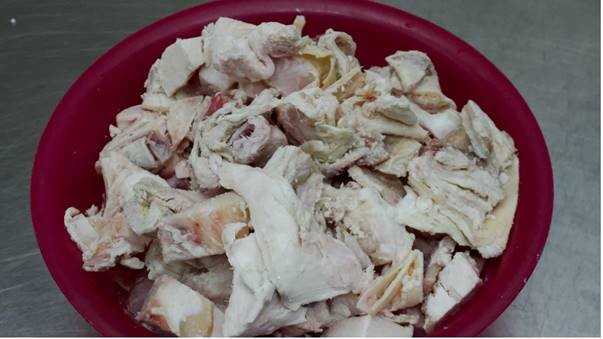Green Cell TechnologiesÒ (GCTÒ), pioneering the future of how organic material (plant and animal) and inorganic material (gold and ceramics) is processed, has now turned its attention to the multi-million-dollar meat industry.
Using its patented Dynamic Cellular DisruptionÒ (DCDÒ) method in combination with its Disruptor technology, GCT has worked with industry experts, to conduct trials on meat cuts usually difficult to process (including 5th quarter), but which, nevertheless contain high value nutrition and other benefits.
GCT has used DCD and Disruptor Technology to completely break down these elements to their molecular level. The resulting product can then be used to form the same meat staples as before – but with a better taste, mouth feel and added nutrition – at a fraction of the time and cost of traditional manufacturing methods. Disruptor technology also replaces the requirement for power-hungry rendering plants.
Being at a molecular level, emulsions derived through GCT’s patented technology have consistent particle size. Because of bigger surface area, the gel formation also has a different dynamic. This gel has a greater ability to create crosslinks and binds together in a homogenous product that holds better than has ever been done before.
Animal skins (with hair), tendons, gristle etc – when deconstructed, are exceptionally high in protein and are rich in collagen and all the more valuable in their molecular form. This can be used for human food or animal food.
Additionally, the company is in final development of technology that will also process the animal skeleton, and which can be integrated into the DCD process.
Trials and trailblazing
Trials were conducted at GCT’s Centre of Excellence in Cape Town, South Africa and involved pork tendons in the first trial and pork tendons & rinds together in the next:
- The DCD emulsions were sent to independent internationally recognized laboratories for analysis (assays available on request.)
- The results conclusively prove that there is vastly reduced to “no growth” Total Microbial Activity (TMA) when using DCD
- Geographical regions differ in legislation however as an example and using 100000cfu’s as an average cut off for safe TMA, we can conclude that the meat emulsions as represented below are still safe for human consumption
- Meat emulsions manufactured and placed in a fridge but not in a final product, will most likely spoil within 2 days. GCT can conclude that DCD extends cold chain shelf life of processed meat emulsions not yet in a final product by 2700% or 2300% for the two trials, respectively.
| Serial | Product | Date | Pre DCD | Post DCD | Date | Post DCD | Date | Post DCD |
| 1 | Tendons Emulsion | 26-05-21 | 180cfu | 10cfu | 19-07-21 | 14000cfu | 21-07-21 | 23200cfu |
| 2 | Tendons, Pork Rinds Emulsion | 03-06-21 | >10000000cfu | No Growth | 19-07-21 | 20000cfu | 21-07-21 | 41600cfu |
Total of 56 days on all samples used
Traditionally, the methods used to derive these products are complicated, costly, labour intensive and time consuming, generally involving heavy machinery. Functional properties of the final product are also diminished – whether this be the protein content in a foodstuff or collagen obtained from the crushing of bones and used for the beauty industry etc.
Also compromised, when using outdated methods of manufacture in foodstuffs, is the organoleptic feel of the product, which generally lacks sophistication, being that the constituents have not been fully broken down.
Eben Van Tonder, a respected South African meat expert who worked with GCT on its trials, remarked: “The disruptor produces a super fine emulsion that contains everything that was in the source material – water, fat and protein, collagen too if it is not spun off for other uses. It also affords manufacturers the opportunity to utilise the entire animal carcass, and the end products contain all the fats, water, protein.”
Van Tonder also observed that a critical benefit of using DCD, is the destruction of pathogens and organisms, noting that the unique and proprietary mechanisms in use through DCD and Disruptor technology, destroys all organisms. Thus, says van Tonder, DCD is also one of the safest ways to process the meat cuts as contamination is taken out of play.
“This is especially important when processing skin and offal – guts for example. Pork skin is very high in listeria but through the Disruptor process, there is no possible chance that any microorganism can survive the process.
“We have been really amazed by the results and yields we are getting out of these trials and I see no reason why Disruptor technology should not be adopted as an industry standard when it comes to processing all these cuts, and more besides.”
Roy Henderson, co-founder, and CEO of GCT is vocal about the necessity for change in the food and beverage processing industry, succinctly pointing out that there is an ever-growing population and less available nutritious protein to keep the world healthy. “This, as we all know, is a disaster in the making as unhealthy people put a drain on resources. Instead of creating alternative protein sources at great cost and complexity, we should make the most of those that are already available to us, and this is where Disruptor technology can play a major role today, and with ease, whilst providing exceptional returns to manufacturers (and the planet) in the process.”
DCD and Disruptor technology can also be extended to plant-based proteins where GCT has shown an average of 132% increase in released proteins by completely opening all the cell structures. Test material in this trial was on butternuts. This dossier is available on request.
As always, the use of DCD and Disruptor technology, has the added benefit of reducing waste to landfill as well as significant overall energy consumption, and is a major contributor in manufacturers achieving their Net Zero imperatives, which can be achieved long in advance of the set goals of 2030.
To watch the meat process in action please click on this link:









[…] Source link […]
Comments are closed.